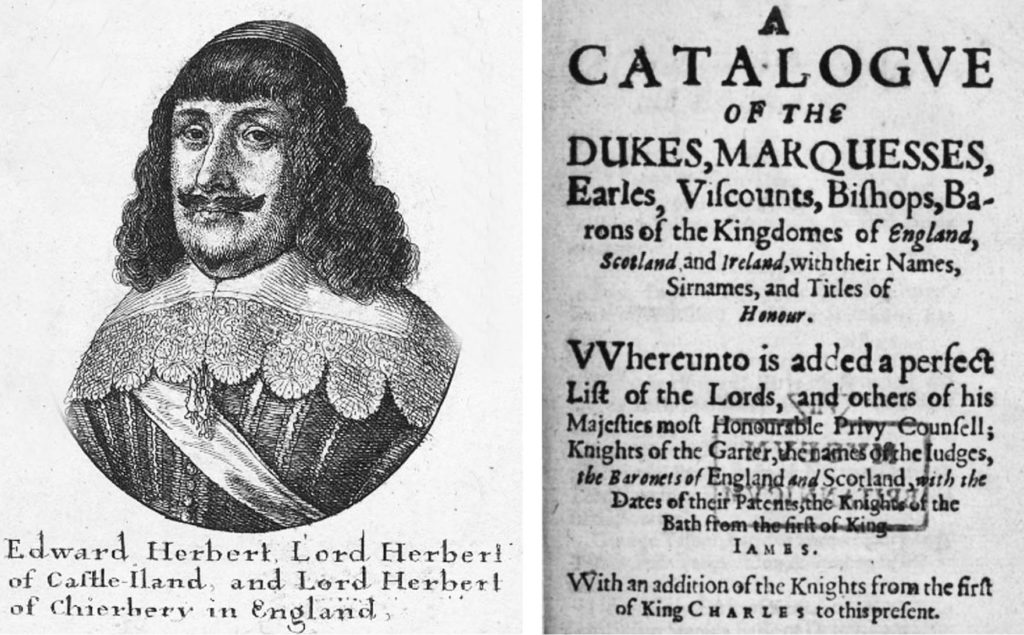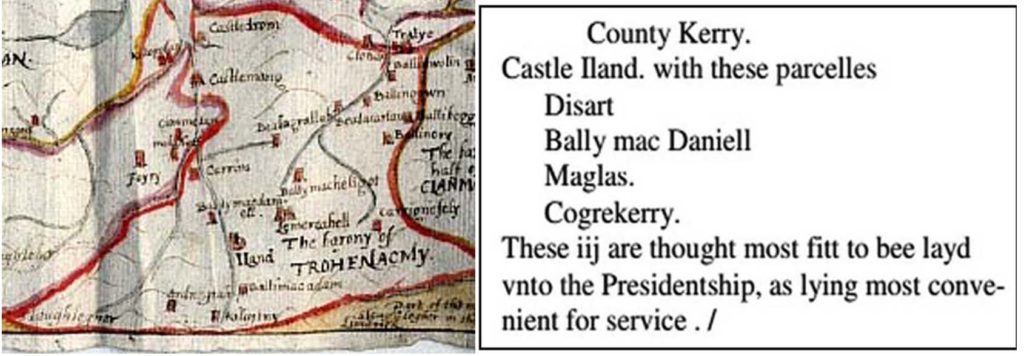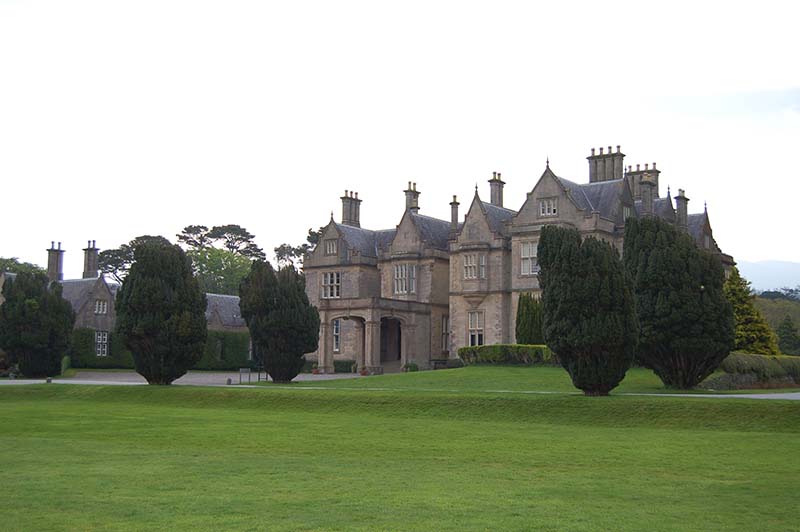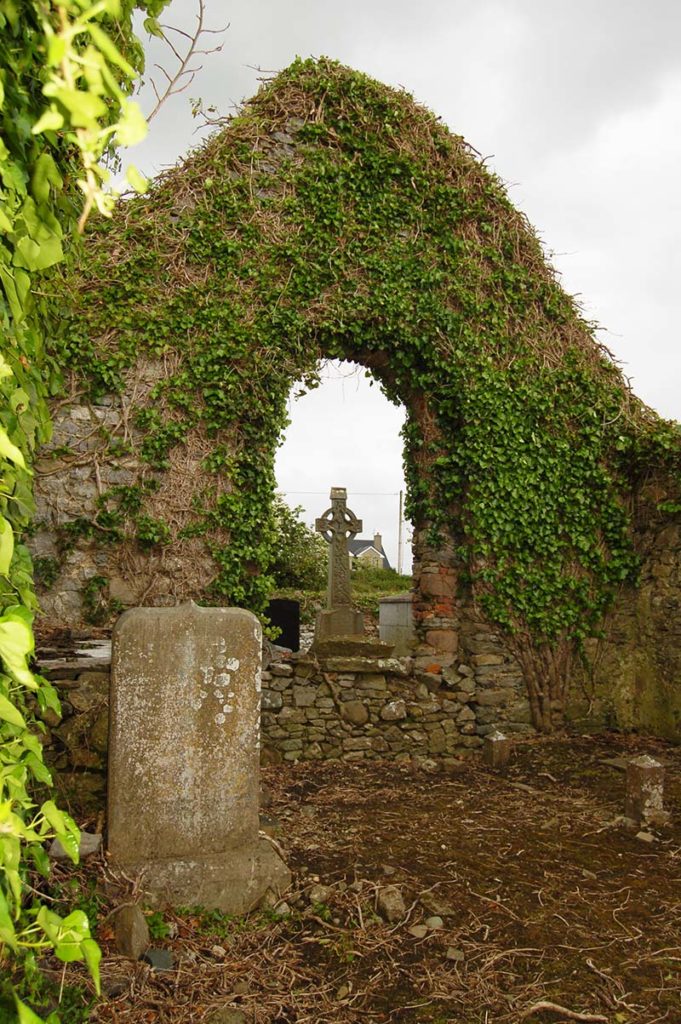Michael O’Donohoe created a useful reference to names and places of local interest found in the 1963 edition of Herbert Correspondence (edited by W J Smith).1 Smith’s introduction to the Correspondence explains its relevance to the Castleisland collection:
The letters printed in this volume constitute all the sixteenth and the greater part of the seventeenth century correspondence among the vast accumulation of Herbert family records …. More than three-quarters of [the letters] were written by or to members of another Herbert family, the Herberts of Montgomery – better known by their peerage title of Herbert of Chirbury.
Herbert of Chirbury (Shropshire) gave title in the English peerage to Sir Edward Herbert, 1st Baron Herbert of Chirbury (1582-1648) – Baron Herbert of Castleisland in the Irish peerage.

Sir Edward Herbert came into possession of estate in Kerry through his marriage in 1599 to his cousin, Mary Herbert (born 1578), daughter of Sir William Herbert of St Julian’s and of Castleisland.
Sir William Herbert (1554-1593) had attained the confiscated lands of Gerald Fitzgerald, 15th Earl of Desmond and desired that it be colonised by ‘English gentlemen’.

Kerry ‘a little England’
To this end, Sir William put into execution many clauses of the statute against Irish customs such as tanistry and the wearing of the native mantle:
He tried to induce the Irish to abandon Roman Catholicism and to this end had the articles of the creed, the Lord’s Prayer, and the ten commandments translated into Irish, directing all the clergy on his estate to read the religious services in the native language. After nearly two years’ residence at Castleisland, he wrote home that he had hopes of making Kerry and Desmond ‘a little England’.2
In 1656, Edward, 3rd Baron Herbert of Chirbury, appointed his cousin, Thomas Herbert of Montgomery, as land agent of the Kerry estate ‘in consideration of the natural love and affection’.
Thomas settled at Kilcow and founded the Herbert family of Muckross.3

Herbert and Historians
In addition to his study of Herbert Correspondence, Michael O’Donohoe collated a comprehensive reference to the Herbert family in Castleisland from the historical works of Charles Smith, Jeremiah King, Thomas F O’Sullivan, Mary Agnes Hickson, Valerie Bary, Fr Kieran O’Shea and others.4
It is an essential starting point for any student of Herbert history in Castleisland.
Arthur Edward Herbert
Material relating to Arthur Edward Herbert of Killeentierna, a landlord and magistrate who was murdered near Castleisland on 30 March 1882, also finds place.5
Notes include Herbert’s burial at Ardcrone, following which it was reported that his remains had been ‘removed by stealth out of the family vault … there is a superstitious objection amongst the peasants against permitting them to be there’.6

A number of ballads about the murder, including one published in The Taxpayers’ News, appear to be a product of the oral tradition:
A for poor Arthur who thought he was smart, B for the bullet that went through his heart; C for the constable who made a great race, D for old Davis who came first to the place; E for the English who will mourn his loss, F for the fatal spot, Lisheenbawn Cross; G for the groan he made when he fell, H for the hurry he showed going to hell; I for the Irish who will laugh at the sport, J for the justice that was shown in the court; K for Kilmainham, where our true men abide, L for the Land League, our hope and our pride; M for magistrates who can make black look white, N for No-Rent that will make our wrongs right; O for Old Ireland that yet will be freed, P for the 'peelers' that sold her for greed; Q for the queen whose use is not known, R for the rifles that keep up her throne; S for the sheriff who was in his train, T for the tales that were all told for gain; U for the union that has done us much harm, V for the villain who grabs up a farm; W for the widow who will for her son mourn, X for Xmas when our church we adorn; Y for our youth who have courage and pride, Z for the zeal of our patriots who died.7

_____________________
1 IE MOD/34. 2 See Dictionary of National Biography 1885-1900 (Sidney Lee, Vol 26): 'His work was severely attacked by Sir Edward Denny, high sheriff of Kerry, and owner of Tralee and the neighbourhood. Herbert's house at Castleisland was destroyed in the rebellion of 1598'. 3 Further reference, 'The Herberts of Muckross' by Sinéad McCoole, Killarney History & Heritage (2005) edited by Jim Larner, pp90-104. 4 IE MOD/35. The material includes genealogy. 5 See also IE MOD/41. 6 Kerry Weekly Reporter, 22 December 1883. IE MOD/35. 7 ie-mod-35-35-3-35-3-2. 'The Ballad of Arthur Herbert' in Taxpayers' News, ref IE MOD/35/35.3.3.


